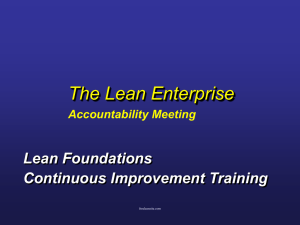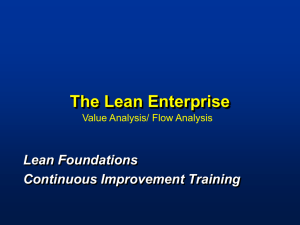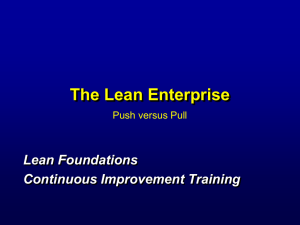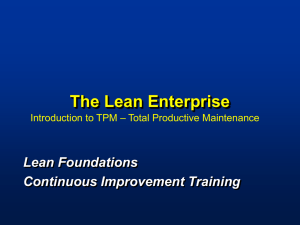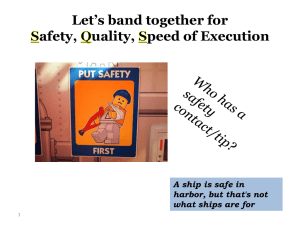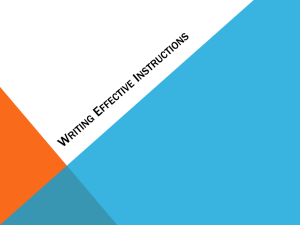“Poka-Yoke” Mistake Proofing
advertisement
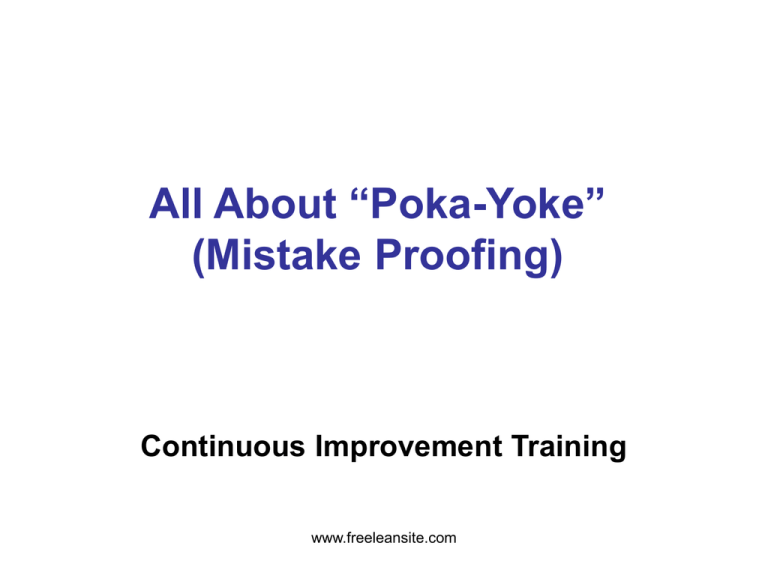
All About “Poka-Yoke” (Mistake Proofing) Continuous Improvement Training www.freeleansite.com Learning Objectives • Understand definition of Poka-Yoke and “zero defect” quality. • Understand the types of inspection and their effectiveness. • Know the three basic functions of a Poka-Yoke device. • See examples of Poka-Yoke devices. • Review step-by-step approach to Poka-Yoke device implementation. • Learn to challenge sources of defects and eliminate them. www.freeleansite.com What Poka-Yoke Means Poka-Yoke was developed by Shigeo Shingo from Toyota Motors as a tool to achieve Zero Defects. • The process of Zero Defects is also known as “Mistake Proofing” or “Fail-Safe”. • By taking over repetitive tasks or actions that depend on vigilance or memory, Poka-Yoke can free workers’ time and mind to pursue more value added activities. www.freeleansite.com Why mistake-proofing is important • Lean practice does not allow extra inventory to compensate for scrap. • Lean ideology focuses on speed ... ... speed cannot exist when defects and rework prevail. • Cost pressures don’t tolerate continued mistakes: scrap, rework, lateness. And most importantly: Our customers rightfully expect defect free products and … Traditional 100% inspection won’t provide 100% defect-free products. www.freeleansite.com Mistake-proofing Philosophy The mistake-proofing philosophy recognizes that people sometimes forget and make errors. The approach uses common-sense ideas and methods in both process and product to eliminate human and mechanical errors. • Historically, great efforts have been made in applying these concepts to Safety and accident prevention. • The same approach must drive intolerance for scrap and rework. Fact: People Make Mistakes. A good Poka-Yoke device makes it impossible to make a mistake. www.freeleansite.com Some Background on Inspection Traditionally, quality is inspected quality. • Judgment Inspection: Separating good from bad after processing. • Informative Inspection: Inspect then take action to eliminate future occurrence. • 100% or Sampling inspection based on SPC (Statistical Process Control) methodologies. Inspection: • assumes defects are inevitable. • believes the process of inspection will reduce defects. • can reinforce ‘quality’ is responsibility of the quality department. • is not 100% effective. All of the above tolerate some level of defects. How do we achieve 0 defects? www.freeleansite.com “Self-Check” Inspection ROI (reliance on operator inspection) emerged in the 1980’s. • A self-check occurs when the person performing the work checks the work before the work moves to the next process step. On the upside .. • 100% coverage is likely. • instant learning and correction are possible. • potentially less resistance when self-discovered. On the downside .. • sometimes compromises are made & proper corrective action skipped. • blind to your own mistakes. • compliance can be marginal if not part of standard work. • key features, characteristics, interface relationships not always understood. www.freeleansite.com “Successive-Check” Inspection A successive-check occurs when the previous work is completed and that work is checked by the next person in the process. On the upside .. • often catches errors overlooked by self-checking process. • can build a sense of cooperation between process participants. On the downside .. • corrective action still required and happens after the point of error. • compliance can be marginal if not part of standard work. • can create friction between workers. Self-check and successive-check was required because the process allowed errors to occur. www.freeleansite.com “Special Cause” Variation Special cause (assignable cause) variation should be attacked first. (A single factor, with little interaction, acting on process causing a large perturbation …) • Tools which are effective in resolving ‘special causes’ have minimal impact on ‘common causes’. - SPC, 7 basic tools (focus to stabilize process) • Different tools and methods are required to effectively identify and improve common cause issues. - PFMEA, DoE (focus to optimize process) Eliminate the common cause variation through repeated application of Poka-Yoke. www.freeleansite.com Make No Mistake Attributes of Zero Defect quality system • source inspection - Checks conditions at the source • 100% Inspection - Simple Poka-Yoke devices in place to check every time the process occurs • immediate Action - Operations stop and corrective action is taken when a defect occurs • teams brainstorm and implement new devices wherever there is an opportunity for error Quality can only be assured when there is always immediate feedback at the source of the defect. www.freeleansite.com Basic Function of Poka-Yoke A defect exists in one of two states: 1. it is about to occur 2. it has already occurred Three basic poka-yoke functions to use against defects: 1. shut down a machine or operation 2. control a process or operation 3. warn that a defect has occurred Recognizing that a defect is about to occur is called PREDICTION. Recognizing that a defect has happened is called DETECTION. www.freeleansite.com Poka-Yoke Culture Focus on building quality into the process. • remember to consider the sources of variation, engage GB and BB support. • make it impossible to create a defect. Believe that inadvertent errors can be eliminated. • engage the people in the process. • 10 heads are better than one. Implement the best ideas after you find the root cause • chase through the five ‘why’s’, then …. Brainstorm to get to the best solution to attack root cause. No more excuses! Build a culture that finds a way to do it right the first time and does not tolerate errors! www.freeleansite.com Contrasting Cultures NEGATIVE APPROACH Mistakes are Inevitable • people make mistakes • place blame • detect at final inspection • sampling inspection • errors are inevitable • no time, no money • no support POSITIVE APPROACH Mistakes Can Be Eliminated • create the ‘right’ environment • focus on the process deficiency • ask “why?”, then “how?” • learn from the opportunity • apply mistake-proofing methods • train everyone to challenge errors. • show them it’s possible; share examples What is the culture in your workplace? What is your approach? www.freeleansite.com Top 10 Errors that Cause Defects 1. Processing omissions (a step was forgotten) 2. Processing errors (something was done incorrectly) 3. Error in setting up the work piece 4. Assembly omissions (a part was forgotten) 5. A wrong part / item was included 6. Wrong work piece 7. Operations errors (incomplete information, procedures not followed) 8. Adjustment, measurement, dimensional errors 9. Equipment maintenance errors 10. Errors in preparation of tools, fixtures, blades, etc Error: When any condition necessary for successful processing is wrong or absent. What is the culture in your workplace? What is your approach? www.freeleansite.com Other Defect Causes – Forgetfulness • Language Barriers- (i.e. English as a second language) • Misunderstanding instruction or procedure • Errors in identification (e.g.: part and/or placement recognition) • Errors made through lack of experience • Pace (too fast or too slow) • Lack of standards, expectations, procedure, or instructions • Incomplete information • Incorrect or incomplete processing (parts, dwell times, etc) • Out of tolerance tools, fixtures, and jigs – adjustment or placement errors What is the culture in your workplace? What is your approach? www.freeleansite.com Common Defect Categories – leaks • mis-wired • loose parts • noise • damaged parts / product • reversed parts • foreign material • mismatched items • misaligned parts • wrong dimensions • ‘inconsistent’ test results • incorrect incoming material • wrong material • missing parts / information What is the culture in your workplace? What is your approach? www.freeleansite.com Examples of Common Devices • guide / reference / interference rod or pin • template • limit switch /micro-switch • counter • odd-part-out method • sequence restriction • critical condition indicator • detect delivery chute • stopper / gate • sensor Remember, the intent is to identify an abnormal condition and prevent further action until the abnormality is removed. www.freeleansite.com Mistake Proofing Device Example A critical condition detector is a device that detects two type of conditions: 1) the presence or absence of a specific, visible pre-set quantity such as the correct number of parts, correct weight, height, volume or depth 2) fluctuations in a non-visible condition such as pressure, temperature, current and non-visible fluids (air). Here’s how it works: a critical manufacturing condition (pressure, current, temperature, time, etc.) is measured and work cannot proceed if the value is not within a predetermined range as indicated on the detector. www.freeleansite.com Critical Condition Device Example • Fluid Element Detectors: Detect changes in air streams occasioned by the placement or removal of objects (useful in detecting broken drill bits). • Pressure Change Detectors: Detect interruptions in flow through pressure gauges or pressure-sensitive switches. • Temperature Change Detectors: Detect temperature change and variation through thermometers, thermostats, thermistors, thermocouples, etc. • Current Fluctuation Detectors: Detect via meter relays occurrence of electric currents or secondary currents (important applications in spot welding). www.freeleansite.com Poka-Yoke Examples Control (prevention): The disc is only able to be inserted in one orientation. www.freeleansite.com Poka-Yoke Examples Shutdown/Warning (Detection): The compact disc will only work in one orientation. www.freeleansite.com Poka-Yoke Examples Shutdown (Prevention): Newer mowers are required to have a safety bar on the handle that must be pulled back in order to start the engine. If you let go of the safety bar, the mower blade stops in 3 seconds or less. www.freeleansite.com KISS Guide to Mistake-proofing Note: This guide assumes a reactive effort (a problem already exists) • Mistake-proofing should be also be used in a proactive mode. • Defects can be prevented by mistake-proofing products and processes at the design stage. Step 1: Describe the defect (or potential defect). Step 2: Determine where the defect is discovered or where it is made. Step 3: Detail the sequence of events in the documented standard. Step 4: Observe the process and detail the steps that differ from the standard. Step 5: Identify contributing conditions (tools, training, etc). Refer to step 4 observations; ask the 5 ‘whys’ to determine root cause. Step 6: Identify the mistake-proof device necessary to prevent the defect. Show the team the Poka-Yoke hints and examples of poka-yoke devices. Step 7: Add the device to the process - Now! www.freeleansite.com Combining Lean And Variation Reduction • Start with an FMEA. This organized approach will identify potential problems that can be addressed with mistake proofing activity. • Process maps can also be beneficial. Understanding the inputs and outputs can help identify specific solutions. Mistake proofing is an excellent opportunity to combine the tools of variation reduction and lean. www.freeleansite.com Poka-Yoke Hints Think about how to verify items by their characteristics • weight, dimension, shape Think about process sequence • can’t perform next step if prior step not done • process flags if steps are omitted Detect deviations from fixed values • counters, scales, odd part out, critical condition detection; pressure, temperature, current, time When brainstorming, review hints and examples to get people thinking. www.freeleansite.com Additional Hints for Defect Prevention Don’t make surplus products • make only what the customer needs, when it is needed • surplus inventory makes poor quality harder to find • in a high inventory environment, the sense of urgency is not there Eliminate, simplify, or combine production operations • identify and eliminate waste; drive 5S • follow standard operations & utilize visual aids Once processed, use immediately • adopt a flow process • implement immediate feedback and action cycles Involve everyone in defect prevention • form action teams - team brainstorming Make daily improvements and invent mistake-proofing devices A Lean environment promotes defect prevention. www.freeleansite.com Engineering Examples Approved parts database which only allows approved parts to be on the BOM Control (preventative) • Checklists (Info missing so drawing does not release) Shutdown (detection) • CAD systems that detect interface issues Warning (detection) And then there’s the design itself. (Alignment pins, keyed connectors, part shapes, part count reduction …) www.freeleansite.com Service and Administrative Examples Approved parts database which only allows approved parts to be on the BOM Control (preventative) • Checklists for requirements gathering during sale process Shutdown (detection) • Reduce complexity of forms ; unneeded fields. • On line forms with required fields - Can’t complete task without complete info in correct format www.freeleansite.com Supply Chain Example MRP provides info related to supply vs. demand Warning (detection) • High priced PO’s can not release without approval Control (prevention) • Approved vendor lists limit suppliers Control (prevention) • Can not complete transaction with missing fields Shutdown (prevention) www.freeleansite.com Summary Every inspection method has weaknesses. • Prevention of defects is better than detection. • Poka-yoke devices can be applied within any process. • Focus on the critical functions and actions. • Sources of defects can be challenged and eliminated. www.freeleansite.com All About “Poka-Yoke” (Mistake Proofing) Continuous Improvement Training www.freeleansite.com
